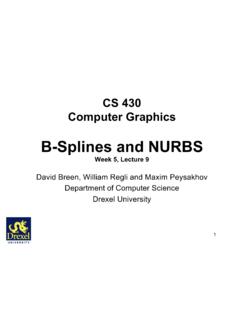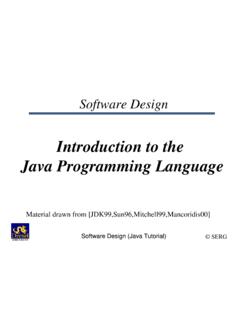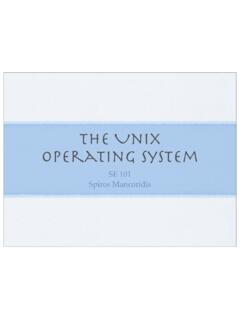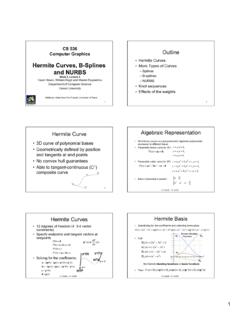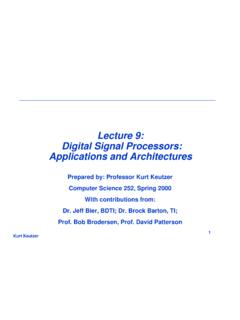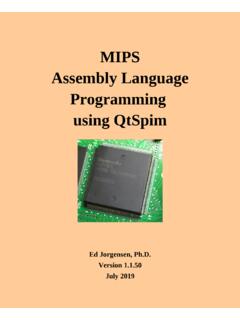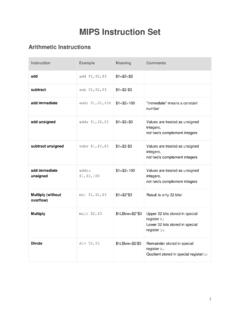Transcription of Floating Point Arithmetic - Drexel CCI
1 Lec 14 Systems Architecture 1 Systems Architecture Lecture 14: Floating Point Arithmetic Jeremy R. Johnson Anatole D. Ruslanov William M. Mongan Some or all figures from Computer Organization and Design: The Hardware/Software Approach, Third Edition, by David Patterson and John Hennessy, are copyrighted material (COPYRIGHT 2004 MORGAN KAUFMANN PUBLISHERS, INC. ALL RIGHTS RESERVED). Lec 14 Systems Architecture 2 Introduction Objective: To provide hardware support for Floating Point Arithmetic . To understand how to represent Floating Point numbers in the computer and how to perform Arithmetic with them. Also to learn how to use Floating Point Arithmetic in MIPS. Approximate Arithmetic Finite Range Limited Precision Topics IEEE format for single and double precision Floating Point numbers Floating Point addition and multiplication Support for Floating Point computation in MIPS Lec 14 Systems Architecture 3 Distribution of Floating Point Numbers 3 bit mantissa exponent {-1,0,1} e = -1e = 0e = X 2^(-1) = 1 X 2^0 = X 2^1 = X 2^(-1) = 5 X 2^0 = 5 X 2^1 = 5 X 2^(-1) = 3 X 2^0 = 3 X 2^1= X 2^(-1) = 7 X 2^0 = 7 X 2^1 = 7/20 1 2 3 Lec 14 Systems Architecture 4 Floating Point An IEEE Floating Point representation consists of A Sign Bit (no surprise) An Exponent ( times 2 to the what?)
2 Mantissa ( Significand ), which is assumed to be (thus, one bit of the mantissa is implied as 1) This is called a normalized representation So a mantissa = 0 really is interpreted to be , and a mantissa of all 1111 is interpreted to be Special cases are used to represent denormalized mantissas (true mantissa = 0), NaN, etc., as will be discussed. Lec 14 Systems Architecture 5 Floating Point Standard Defined by IEEE Std 754-1985 Developed in response to divergence of representations Portability issues for scientific code Now almost universally adopted Two representations Single precision (32-bit) Double precision (64-bit) Lec 14 Systems Architecture 6 IEEE Floating - Point Format S: sign bit (0 non-negative, 1 negative) Normalize significand: |significand| < Always has a leading pre-binary- Point 1 bit, so no need to represent it explicitly (hidden bit) Significand is Fraction with the 1.
3 Restored Exponent: excess representation: actual exponent + Bias Ensures exponent is unsigned Single: Bias = 127; Double: Bias = 1203 S Exponent Fraction single: 8 bits double: 11 bits single: 23 bits double: 52 bits Bias)(ExponentS2 Fraction)(11)(x Lec 14 Systems Architecture 7 Single-Precision Range Exponents 00000000 and 11111111 reserved Smallest value Exponent: 00000001 actual exponent = 1 127 = 126 Fraction: significand = 2 126 10 38 Largest value exponent: 11111110 actual exponent = 254 127 = +127 Fraction: significand 2+127 10+38 Lec 14 Systems Architecture 8 Double-Precision Range Exponents and reserved Smallest value Exponent: 00000000001 actual exponent = 1 1023 = 1022 Fraction: significand = 2 1022 10 308 Largest value Exponent: 11111111110 actual exponent = 2046 1023 = +1023 Fraction: significand 2+1023 10+308 Lec 14 Systems Architecture 9 Representation of Floating Point Numbers IEEE 754 single precision 31 30 23 22 0 Sign Biased exponent Normalized Mantissa (implicit 24th bit = 1) (-1)s F 2E-127 ExponentMantissaObject Represented0000non-zerodenormalized1-254 anythingFP number2550pm infinity255non-zeroNaNLec 14 Systems Architecture 10 Why biased exponent?
4 For faster comparisons (for sorting, etc.), allow integer comparisons of Floating Point numbers: Unbiased exponent: Biased exponent: 0 1111 1111 000 0000 0000 0000 0000 0000 0 0000 0001 000 0000 0000 0000 0000 0000 1/2 2 0 0111 1110 000 0000 0000 0000 0000 0000 0 1000 0000 000 0000 0000 0000 0000 0000 1/2 2 Lec 14 Systems Architecture 11 Basic Technique Represent the decimal in the form +/- x 2y And fill in the fields Remember biased exponent and implicit 1. mantissa! Examples: : 0 00000000 00000000000000000000000 ( x 2^0): 0 01111111 00000000000000000000000 ( binary = x 2^-1): 0 01111110 00000000000000000000000 ( binary = x 2^-1): 0 01111110 10000000000000000000000 (11 binary = *2^1): 0 10000000 10000000000000000000000 ( binary = *2^-2): 1 01111101 10000000000000000000000 1 10000011 01000000000000000000000 = - * 2^4 = Copyright 2003 - Russell C. Bjork Lec 14 Systems Architecture 12 Basic Technique One can compute the mantissa just similar to the way one would convert decimal whole numbers to binary.
5 Take the decimal and repeatedly multiply the fractional component by 2. The whole number portion is the next binary bit. For whole numbers, append the binary whole number to the mantissa and shift the exponent until the mantissa is in normalized form. Lec 14 Systems Architecture 13 Floating - Point Example Represent = ( 1)1 2 1 S = 1 Fraction = Exponent = 1 + Bias Single: 1 + 127 = 126 = 011111102 Double: 1 + 1023 = 1022 = 011111111102 Single: Double: Lec 14 Systems Architecture 14 Floating - Point Example What number is represented by the single-precision float S = 1 Fraction = Fxponent = 100000012 = 129 x = ( 1)1 (1 + 012) 2(129 127) = ( 1) 22 = Lec 14 Systems Architecture 17 Representation of Floating Point Numbers IEEE 754 double precision 31 30 20 19 0 Sign Biased exponent Normalized Mantissa (implicit 53rd bit) (-1)s F 2E-1023 ExponentMantissaObject Represented0000non-zerodenormalized1-204 6anythingFP number20470pm infinity2047non-zeroNaNLec 14 Systems Architecture 18 Floating Point Arithmetic fl(x) = nearest Floating Point number to x Relative error (precision = s digits) |x - fl(x)|/|x| 1/2 1-s for = 2, 2-s Arithmetic x y = fl(x+y) = (x + y)(1 + ) for < u x y = fl(x y)(1 + )
6 For < u ULP Unit in the Last Place is the smallest possible increment or decrement that can be made using the machine's FP Arithmetic . Lec 14 Systems Architecture 19 Floating - Point Precision Relative precision all fraction bits are significant Single: approx 2 23 Equivalent to 23 log102 23 6 decimal digits of precision Double: approx 2 52 Equivalent to 52 log102 52 16 decimal digits of precision Lec 14 Systems Architecture 20 Is FP addition associative? Associativity law for addition: a + (b + c) = (a + b) + c Let a = x 1023, b = x 1023, and c = a + (b + c) = x 1023 + ( x 1023 + ) = x 1023 + x 1023 = (a + b) + c = ( x 1023 + x 1023 ) + = + = Beware Floating Point addition not associative! The result is Why the smaller number disappeared? Lec 14 Systems Architecture 21 Floating Point addition Still normalized?4. Round the significand to the appropriatenumber of bitsYesOverflow orunderflow?
7 StartNoYesDone1. Compare the exponents of the two the smaller number to the right until itsexponent would match the larger exponent2. Add the significands3. Normalize the sum, either shifting right andincrementing the exponent or shifting leftand decrementing the exponentNoExceptionSmall ALUE xponentdifferenceControlExponentSignFrac tionBig ALUE xponentSignFraction010101 Shift right0101 Increment ordecrementShift left or rightRounding hardwareExponentSignFractionLec 14 Systems Architecture 22 Floating - Point Addition Consider a 4-digit decimal example 101 + 10 1 1. Align decimal points Shift number with smaller exponent 101 + 101 2. Add significands 101 + 101 = 101 3. Normalize result & check for over/underflow 102 4. Round and renormalize if necessary 102 Lec 14 Systems Architecture 23 Floating - Point Addition Now consider a 4-digit binary example 2 1 + 2 2 ( + ) 1.
8 Align binary points Shift number with smaller exponent 2 1 + 2 1 2. Add significands 2 1 + 2 1 = 2 1 3. Normalize result & check for over/underflow 2 4, with no over/underflow 4. Round and renormalize if necessary 2 4 (no change) = Lec 14 Systems Architecture 24 FP Adder Hardware Much more complex than integer adder Doing it in one clock cycle would take too long Much longer than integer operations Slower clock would penalize all instructions FP adder usually takes several cycles Can be pipelined Lec 14 Systems Architecture 25 FP Adder Hardware Step 1 Step 2 Step 3 Step 4 Lec 14 Systems Architecture 26 Floating Point Multiplication Algorithm Lec 14 Systems Architecture 29 FP Arithmetic Hardware FP multiplier is of similar complexity to FP adder But uses a multiplier for significands instead of an adder FP Arithmetic hardware usually does Addition, subtraction, multiplication, division, reciprocal.
9 Square-root FP integer conversion Operations usually takes several cycles Can be pipelined Lec 14 Systems Architecture 30 FP Instructions in MIPS FP hardware is coprocessor 1 Adjunct processor that extends the ISA Separate FP registers 32 single-precision: $f0, $f1, .. $f31 Paired for double-precision: $f0/$f1, $f2/$f3, .. Release 2 of MIPs ISA supports 32 64-bit FP reg s FP instructions operate only on FP registers Programs generally don t do integer ops on FP data, or vice versa More registers with minimal code-size impact FP load and store instructions lwc1, ldc1, swc1, sdc1 , ldc1 $f8, 32($sp) Lec 14 Systems Architecture 31 FP Instructions in MIPS Single-precision Arithmetic , , , , $f0, $f1, $f6 Double-precision Arithmetic , , , , $f4, $f4, $f6 Single- and double-precision comparison , (xx is eq, lt, le, ..) Sets or clears FP condition-code bit $f3, $f4 Branch on FP condition code true or false bc1t, bc1f , bc1t TargetLabel Lec 14 Systems Architecture 32 FP Example: F to C C code: float f2c (float fahr) { return (( )*(fahr - )); } fahr in $f12, result in $f0, literals in global memory space Compiled MIPS code: f2c: lwc1 $f16, const5($gp) lwc2 $f18, const9($gp) $f16, $f16, $f18 lwc1 $f18, const32($gp) $f18, $f12, $f18 $f0, $f16, $f18 jr $ra Lec 14 Systems Architecture 33 Rounding Guard and round digits and sticky bit When computing result, assume there are several extra digits available for shifting and computation.
10 This improves accuracy of computation. Guard digit: first extra digit/bit to the right of mantissa -- used for rounding addition results Round digit: second extra digit/bit to the right of mantissa -- used for rounding multiplication results Sticky bit: third extra digit/bit to the right of mantissa used for resolving ties such as vs. Lec 14 Systems Architecture 34 Rounding examples An example without guard and round digits Add x 1025 and x 1024 assuming 3 digit mantissa Shift mantissa of the smaller number to the right: x 1025 Add mantissas: 1025 Check and normalize mantissa if necessary: 1026 An example with guard and round digits Add x 1025 and x 1024 assuming 3 digit mantissa Internal registers have extra two digits: x 1025 and x 1024 Shift mantissa of the smaller number to the right: x 1025 Add mantissas: x 1025 Check and normalize mantissa if necessary: x 1026 Round the result: x 1026 Lec 14 Systems Architecture 35 Rounding examples An example without guard and round digits Add x 1025 and x 1024 assuming 3 digit mantissa Shift mantissa of the smaller number to the right: x 1025 Add mantissas: x 1025 Normalize mantissa if necessary.

